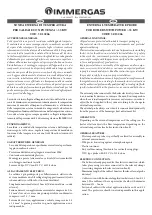
TROUBLESHOOTING
7-4
KC1000 WATER HEATER TROUBLESHOOTING TABLE – Continued
FAULT INDICATION
PROBABLE CAUSES
CORRECTIVE ACTION
FFWD TEMP
SENSOR FAULT
1. Loose or broken wiring.
2. Defective Sensor.
3. Incorrect Sensor.
1. Inspect feed forward (BTU transmitter)
sensor for loose or broken wiring.
2. Check resistance of sensor to determine if it
is within specification.
3. Ensure that the correct sensor is installed.
FLAME LOSS
DURING RUN
1. Worn Flame Detector or
cracked ceramic.
2. Defective Differential
Regulator.
3. Poor combustion calibration.
4. Debris on burner.
5. Blocked condensate drain.
1. Remove and inspect the Flame Detector for
signs of wear or cracked ceramic. Replace if
necessary.
2. Check gas pressure readings using a gauge
or manometer into and out of the Air/Fuel
Valve to ensure that the gas pressure into
and out of the valve is correct.
3. Check combustion calibration. Adjust as
necessary.
4. Remove the burner and inspect for any
carbon or debris. Clean and reinstall.
5. Remove blockage from condensate drain.
HEAT DEMAND
FAILURE
1. The Heat Demand Relays on
the Ignition/Stepper (IGST)
board failed to activate when
commanded
2. Relay is activated when not in
Demand
1. Press CLEAR button and restart the unit. If
the fault persists, replace IGST Board.
2. Defective relay. Replace IGST Board.
HIGH EXHAUST
TEMPERATURE
1. Defective exhaust sensor.
2. Carboned heat exchanger due
to incorrect combustion
calibration
1. Measure the actual exhaust temperature and
continuity of the exhaust sensor. If the
exhaust temperature is less than 500
o
F and
the exhaust sensor shows continuity replace
the sensor.
2. If exhaust temperature is greater than 500
o
F, check combustion calibration. Calibrate or
repair as necessary.
HIGH GAS
PRESSURE
1. Incorrect supply gas pressure.
2. Defective Supply Regulator or
Wrong Style Regulator
1. If using a non-lock up style regulator for the
gas supply, measure static gas pressure
downstream, it should be 14”WC or less.
Adjust as necessary.
2. If gas supply pressure cannot be lowered, a
lock-up style regulator may be required or the
supply regulator may be defective.
















































